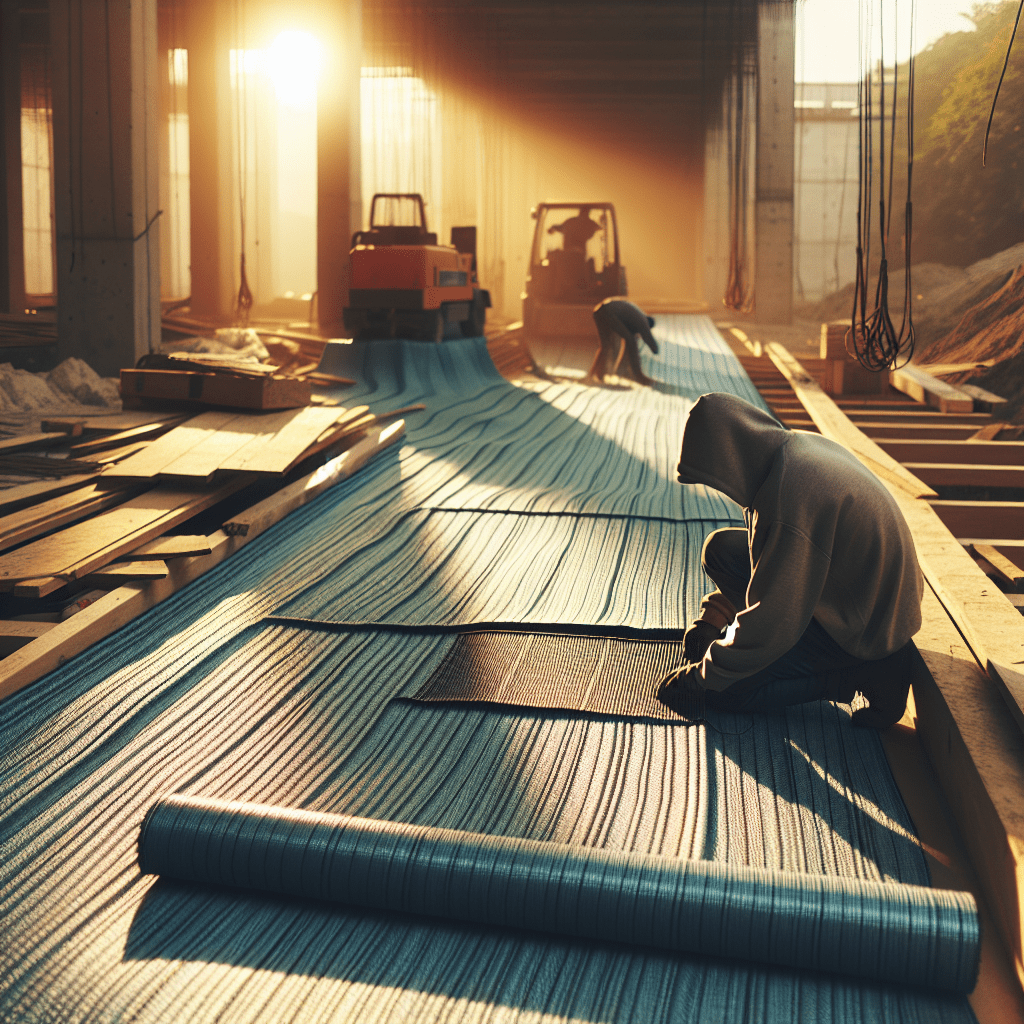Introduction to Geotextile Fabric in Construction
Wondering how roads stay intact for years, or how landfills protect against leaks? The answer lies in a powerful construction component: geotextiles. Geotextile fabric plays a pivotal role in construction by improving ground stability, acting as a separator, filter, and protector against potential damages. It’s no wonder that the geosynthetics market, including geotextiles, is expected to reach $6.5 billion by 2025, reflecting their widespread usage.
In this article, we will explore the mechanism and significance of geotextile fabric in construction. We’ll discuss its various purposes, types, and real-world applications. By the end, you’ll gain a comprehensive understanding of how geotextile fabric influences everything from road construction to landscaping and gardening, and why it’s indispensable to the modern construction industry.
Geotextile Fabric in Construction
The Role of Geotextile Fabric
- Geotextile fabric is used in construction to enhance the ground’s stability and support structures.
- It is typically made from synthetic materials such as polyester or polypropylene.
- This fabric is permeable, allowing water to pass through while retaining soil and substrates.
Main Purposes of Geotextile Fabric
Separation
Geotextile fabric is used to separate different layers of soil and materials, preventing them from mixing. This is essential in road construction, where it keeps the aggregate layers intact, ensuring longevity and performance.
Filtration
The fabric allows water to pass while preventing soil particles from moving. This function is vital in drainage applications where maintaining the integrity of the drainage system is key.
Reinforcement
Geotextile fabric reinforces the soil, increasing its load-bearing capacity. This is important in embankment construction and other structures that need additional support.
Protection
It protects other materials from damage and erosion. For example, in landfill sites, geotextile fabric can shield geomembranes from punctures and tears.
| Application | Function |
|---|---|
| Road Construction | Separation, Reinforcement |
| Drainage Systems | Filtration |
| Landfills | Protection |
| Embankments | Reinforcement |
Types of Geotextile Fabric
- Woven Geotextiles: Made by weaving fibers together. They provide high load capacity and are used for reinforcement and separation.
- Non-Woven Geotextiles: Created through the bonding of fibers. They are typically used for filtration and drainage due to their permeability.
Real-World Applications
One notable example includes the use of geotextile fabric in the construction of the Federal Highway Administration‘s various projects. These fabrics ensure that roads and highways maintain their structural integrity over time.
Installation of Geotextile Fabric
Preparation Phase
The installation process begins with site preparation. This involves clearing any debris or unwanted materials from the location. Also, uneven surfaces need to be leveled to provide a smooth base. Proper groundwork preparation ensures optimal performance of the geotextile fabric.
Laying the Fabric
Once the surface is prepared, the geotextile fabric can be unrolled and laid onto the surface. It should be applied with the edges overlapped to create a barrier. To prevent the fabric from moving, it is important to secure it with pins or staples.
Overlap Consideration
The extent of the overlap depends largely on the site conditions and the type of soil. Standard practice demands an overlap of approximately 2 feet. In instances of steep slopes or heavy-traffic areas, more overlap may be needed to ensure stability.
Fabric Covering
After the successful overlay of the fabric, a layer of gravel, soil, or other material is spread over it. This layer serves to anchor the geotextile, protects it, and assists in carrying out its primary function—whether separation, filtration, or reinforcement.
Post-Installation
Once the geotextile is completely covered, it’s essential to inspect the site for any visible fabric or misplaced objects. Removal of these objects reduces the risk of puncturing or damaging the fabric.
Maintenance of Geotextile Fabric
Inspection
Periodical inspection of geotextile fabric installations is important to ensure their long-term performance. Keeping an eye out for signs of erosion, drainage issues, or structural instability can help detect potential problems early.
Repair
If a problem is detected, immediate action should be taken to rectify it. This could include adding more cover material, reestablishing proper grading, or replacing damaged portions of the geotextile fabric.
Proper Documentation
Keeping a detailed record of inspections and any action taken helps in future maintenance and provides a comprehensive history of the installation. This helps in understanding performance trends and planning preventative measures.
Geotextile Installation Resource
For those wanting to understand this topic more deeply, this resource provides a comprehensive guide on how geotextile fabric should be installed, ensuring the maximization of its benefits over time.
Geotextile Fabric in Construction
The Benefits of Geotextile Fabric
- Prevents intermixing of different soil layers, which maintains the strength and integrity of the substructure.
- Becomes an essential element in erosion control for slopes, embankments, and coastlines.
- Curbs weed growth effectively, providing an eco-friendly solution for landscaping and gardening.
How Geotextile Fabric Handles Water
Permeability
Geotextile fabric does let water through. Its permeable nature allows for effective water drainage, preventing waterlogging and enabling the soil to retain necessary moisture levels while protecting the integrity of the subsoil and any structures built upon it.
Filtration in Action
By allowing water to pass through freely, geotextile fabric facilitates natural filtration processes. It traps soil particles, preventing them from being carried away by the water, which helps maintain soil stability and prevents erosion.
Applied Uses
In agriculture, geotextile fabrics can assist in irrigation systems by ensuring even water distribution without soil displacement. In urban settings, they are used in green roofs and rain gardens to support drainage while sustaining plant life. For comprehensive information, sources like the Federal Highway Administration provide valuable insights into these applications.
Geotextile Fabric in Landscaping and Gardening
Weed Barrier
When used in landscaping, geotextile fabric provides an effective barrier against weed growth. It allows water and nutrients to reach desired plants while restricting weeds by blocking sunlight and restricting soil mobility for unwanted flora.
Soil Stabilization
Geotextile fabric stabilizes soil in garden beds, paths, and slopes. This stability is essential for maintaining the structure of terraces and other landscaping features, reducing the risk of erosion and soil displacement.
Efficient Mulching
Using geotextile fabric under mulch in gardens enhances the mulch’s effectiveness by providing a solid base that prevents decomposition from eroding the soil. It also encourages better moisture retention and stops weed growth.
Types of Geotextile Fabrics
Specialized Geotextiles
- Heat-Bonded Geotextiles: These fabrics undergo a thermal bonding process, resulting in a stronger weave with reduced pore size, ideal for specific filtration applications.
- Biodegradable Geotextiles: Made from organic materials, these are designed to break down over time, making them suitable for temporary applications such as short-term erosion control.
Advanced Properties
Modern geotextile fabrics are engineered to withstand different chemical and environmental stresses, enhancing their durability and application range. Innovations in material science have led to fabrics that resist ultraviolet (UV) degradation and maintain functionality over longer periods.
Implementation Strategies for Geotextile Fabric
Proper Placement
Anchoring Techniques
Anchoring the fabric securely is essential, especially in areas prone to high winds or water movement. Using U-shaped pins, large staples, or trenching the edges can prevent the fabric from shifting out of place.
Material Selection
Choosing the right type of geotextile fabric for the specific application is essential. Non-woven fabrics are ideal for filtration and drainage, while woven fabrics are better suited for stabilization and reinforcement tasks.
Maintenance Best Practices
Regular inspection for tears, punctures, or displacement can prolong the functional life of geotextile fabric. Implementing a maintenance schedule based on the specific environment and usage can ensure the fabric continues to provide its intended benefits effectively.
Disadvantages of Geotextile Fabric
Durability Concerns
- Physical Damage: While geotextile fabrics are robust, they can be susceptible to punctures and tears from sharp objects or heavy machinery during installation.
- UV Degradation: Prolonged exposure to sunlight can degrade certain types of geotextile fabrics, reducing their effectiveness over time.
Cost Issues
- Initial Investment: The cost of high-quality geotextile fabric can be significant, impacting budget allocations for construction projects, especially large-scale ones.
- Installation Costs: Proper installation requires skilled labor and equipment, potentially increasing overall project expenses.
Environmental Impact
- Non-Biodegradable Materials: Most geotextile fabrics are made from synthetic materials like polyester and polypropylene, which do not decompose and can contribute to long-term environmental pollution.
- Microplastic Concerns: Over time, synthetic geotextiles can break down into microplastics, posing a risk to soil and water ecosystems.
Functionality Limitations
- Clogging: In filtration applications, geotextile fabrics can become clogged with fine particles, reducing their permeability and effectiveness over time.
- Load Bearing Limits: Though they reinforce soil, geotextiles have load-bearing limits and may not be suitable for extremely heavy structures without additional reinforcement.
Maintenance Challenges
- Regular Monitoring: Continuous inspection and maintenance are required to ensure long-term performance, which can be time-consuming and costly.
- Repair Complexities: Repairing damaged geotextile fabric can be complex, often requiring partial removal of overlying layers and professional expertise.
Case Studies of Geotextile Failures
| Project | Issue | Outcome |
|---|---|---|
| Flood Defense | Clogging | Reduced water flow and increased flood risk |
| Road Embankment | Punctures During Installation | Structural instability and increased maintenance costs |
| Landfill | UV Degradation | Leachate leakage and environmental contamination |
Wrapping it Up
Geotextile fabric, a modern marvel of engineering, plays a significant role in multiple sectors, particularly in construction, landscaping, and gardening. Its applications are diverse, varying from erosion control, weed suppression to soil filtration and stabilization. Various types of geotextile fabric, such as woven, non-woven and specialized ones like heat-bonded and biodegradable geotextiles, cater to varied needs.
Despite certain challenges such as susceptibility to physical damage, potential UV degradation, and costs, with proper implementation strategies and maintenance, geotextile fabrics have the potential to sustain functionality over long durations while adding significant value to the projects they are used in.
Frequently Asked Questions – FAQs
What is the main benefit of using geotextile fabric in construction projects?
Geotextile fabric brings numerous benefits to construction projects, including preventing soil intermixing, providing stabilization, enhancing water drainage and offering protection against erosion.
What are the primary types of geotextile fabric?
Commonly used types of geotextile fabric include woven and non-woven. While woven geotextiles offer high load capacity, non-woven ones excel in filtration and drainage.
Do geotextile fabrics have an environmental impact?
Most geotextiles are made from synthetic materials like polyester and polypropylene, which are non-biodegradable. Over time, these can degrade into microplastics, potentially affecting soil and water ecosystems.
What are the common challenges faced when using geotextile fabric?
Challenges using geotextile fabrics range from potential physical damage and UV degradation to increased initial and installation costs. Additionally, functionality limitations and routine maintenance requirements can pose difficulties.






